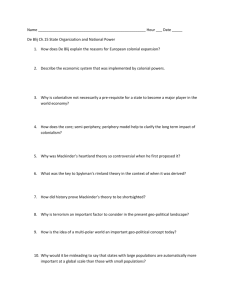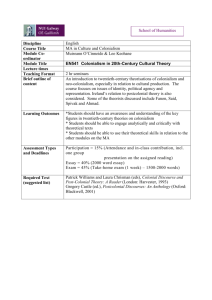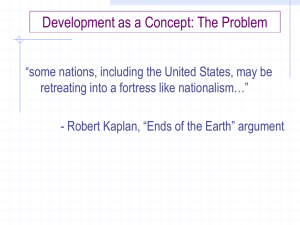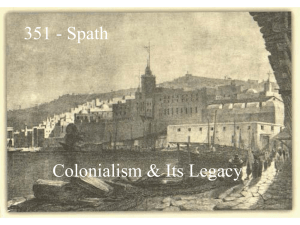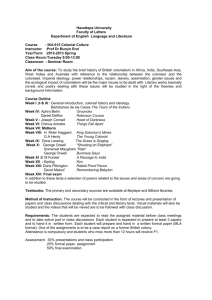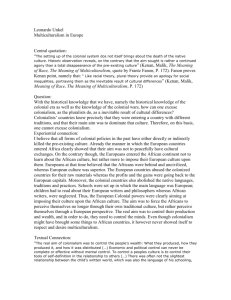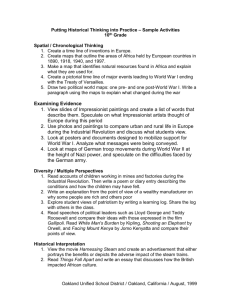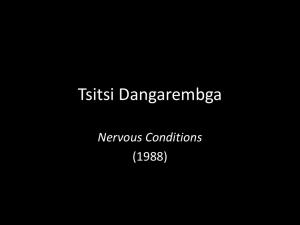Programs and Projects
advertisement
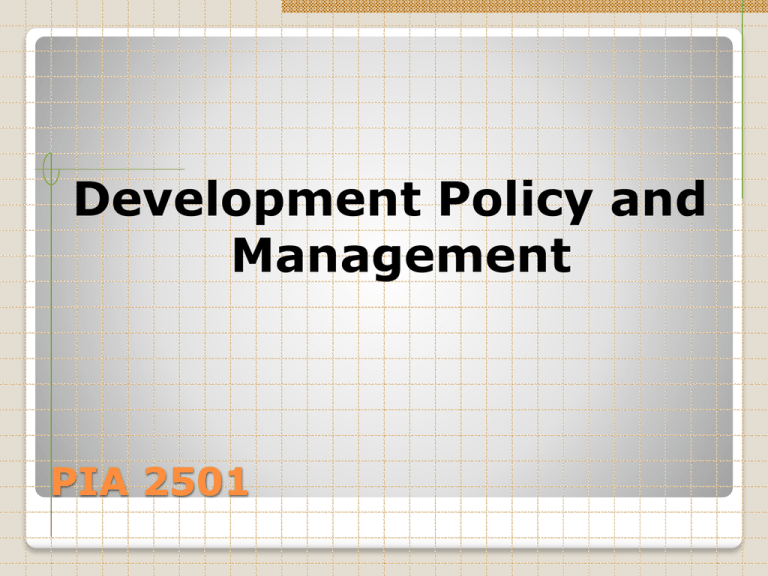
Development Policy and Management PIA 2501 THE NATURE OF THE DEBATE The Nature of the Debate I. The Situation Today II. The Impact of Colonialism III. Twentieth Century Authoritarianism IV. The End of Colonialism V. Keynesianism and the “Western” Development Model Major Themes The Situation Today The industrialized countries, which accounted for 40 percent of the world's population after World War II, now account for only 20 percent, though they earn 85 percent of the world's income. Development as a Concept: The Problem In the coming decades, the industrialized world is expected to make up only 12 to 15 percent of the planetary population, as 90 to 95 percent of all births take place in the poorest countries. “I [see] around the world-poverty, the collapse of cities, porous borders, cultural and racial strife, growing economic disparities, weakening nationstates--We are not in control...” (Robert Kaplan) At Issue: Robert D. Kaplan Development as a Concept: The Image Robert Kaplan’s view: Economic and social development is “generally cruel, painful, violent, and uneven…” Development as a Concept: The Controversy “some nations, including the United States, may be retreating into a fortress like nationalism…” - Robert Kaplan, “Ends of the Earth” argument Certain countries are separating and being separated from the world economy. ◦ Most of Africa except Egypt and South Africa ◦ Parts of Indian sub-continent- Burma, Sri Lanka- Central Asia ◦ Parts of the non-Oil Middle East ◦ Parts of South East Asia-Cambodia and Laos◦ Parts of Central/South America and the Balkans follows The Ends of the Earth Argument Robert Kaplan, The Ends of the Earth: A Journey at the Dawn of the 21st Century (New York: Random House: 1996). Reference Robert D. Kaplan (born in 1952)) is an American journalist. He is currently an editor for the Atlantic Monthly. His writings have also been featured in the Washington Post, the New York Times and the Wall Street Journal, among other newspapers and publications. He is known for his controversial essays about the nature of U.S. power have spurred debate in academia, the media, and the highest levels of government. A frequent theme in his work is the reemergence of cultural and historical tensions temporarily suspended during the Cold War. He has traveled to and reported on more than 80 countries. Author of the Week Robert D. Kaplan History is Important Culture Defines Choices Start with empirical reality and normative choices follow Regional Analysis is Important Picard’s Perspective Okot p'Bitek Paul Theroux Ugandan Poet Influence: Transition Authors Okot p’Bitek—Uganda novelist “Foreign ‘Experts’ and Peace Corps swarm the Country Like white Ants.” (Transition Magazine, 1966) Picard first read in Masaka Uganda, when it was first published Quote of the Day Barack Obama, Dreams from My Father: A Story of Race and Inheritance (New York: Three Rivers Press, 2004), pp. 392-430. (Africa) Barack Obama, The Audacity of Hope: Thoughts on Reclaiming the American Dream (New York: Vintage Books, 2006), Chapter Eight, pp. 320-382. (General and Southeast Asia) Note: Suggested Reading Historical Structures ◦ Overseas colonial structures, land-based colonialism, post-colonial society Problems of Defining Development and Modernization Theory Colonial Underdevelopment Argument How Did We Get to this Point? The Impact of Colonialism Periods: 1. Age of Exploration 2. Early Colonialism- Mercantilism 3. De Jure or Formal Colonialism 4. Old vs. New Colonialism 5. Land Based Colonial Empires 6. De Facto (Neo) Colonialism 7. Authoritarianism and the End of Empire 8. Decolonization after WWII 9. Nationalism, Independence and Theories of Development Overseas Colonial Structures, Values, (1500-1960) and Post-Colonial Society 1. Age of Expansion: 1500-1700. Extraction and Exploration. Dominated by Spain, Portugal and later Holland 2. Overseas colonialism (Mercantilism Phase-1700-1856- French and British) The creation of external trade patterns and government expenditures directed toward the development of an export economy 3. “De Jure” colonialism: After 1856 Legal and internationally recognized formal control of government structures when trade, economic and governmental sectors of a society are formally or legally controlled by another country Age of Exploration Colonial Structures, Values, and PostColonial Society (1500-1950) 4. “Old Colonialism” vs. “New Colonialism” (after 1920) a. Early colonial development focused on infrastructure to support export and import trade b. Human resource development was neglected c. ideology of Free trade that masked a reality which developed markets for mother country goods and provided raw materials for industrial production d. New Colonialism- Modernization and Westernization (1920-1950) The Colonial Governor (The Prefect Model) Named the district officer, magistrate, landrost, district commissioner, the commandant, the collector (Asia, Africa, Middle East, East Europe) By contrast, administration was Functional in Spanish Latin America, Philippines, and in some Neo-Colonial systems—no prefect Government expenditure was limited to the military and police prior to 1920s Early Colonial Control: The Colonial Prefect- World Wide 5. European Empires Do the terms colonialism and underdevelopment work for Eastern Europe, the CIS, Central Asia and the Caucasus? Administrative structures were similar to those of overseas colonialism After 1989, These are often labeled “Transitional States” Land Based Colonialism Archduke Franz Ferdinand Janine Wedel, in Collision and Collusion, raises two questions: ◦ Are transitional states “developmental?” ◦ Are they transitional? What does she mean? Land Based Colonialism 6. De Facto Colonialism No formal legal ties but in practice power relationships between colonial powers and puppet regimes ◦ Thailand, Ethiopia, Persia, Nepal, the Arabian Peninsula, and Afghanistan, much of Latin America after the 1850s ◦ Parallel between formal colonial systems and informal influence ◦ Neo-colonialism after 1960 De Facto vs. Neo-Colonialism TEN MINUTE BREAK Break Time 7. Authoritarianism and the End of Empires Nationalism and Development“Five Minute History 1. Neo-Nationalism- Royalist Conservatism in Europe and Asia 2. Corporatism Fascism 3. Socialism/Communism 4. Keynesianism 5. New Orthodoxy Looked to Model of Japan prior to World War II (Toland Book) Nationalism developed in the 1930s and 1940s throughout much of the colonial world including much of central and Eastern Europe. It had four variations. Japan: Nationalism and the End of Empire Japan and the History of Development (Toland, The Rising Sun): Two Questions What was the Pre-War Japanese Government view of Colonialism in Asia? Why is Japan Important in the development of nationalism in Africa and Asia? ◦ For Further Reading: Herbert P. Bix, Hirohito and the Making of Modern Japan (New York: Harper Collins, 2000). 1. Dominant Nationalism 2. Absence of Renaissance: Central Europe 3. Multi-ethnicity and land based expansion 4. Revolutionary Transformation and Collapse in the 20th Century 5. Primacy of the Party under “National Socialism” 6. Prefectoral Model of local state: Party Authority 7. Promoted a Mobilizing and social engineering model of state transformation Central European Corporatism: Socialism and Fascism WWII Neo-Nationalism in Europe and Latin America (1930s) António de Oliveira Salazar (1932)Portuguese Overseas Territories Franco and the Spanish Civil War Peronism (Juan Peron: Argentina 1944) Impact of the functions of government ◦ Territorial Governors appointed by the President (Prefects) ◦ The importance of Military control in regions Spanish Military Governors called Presidencies Juan and Eva Peron and Francisco Franco “The Leaders” Patronage (The Universal Problem) ◦ Legalistic basis of governance in principle ◦ ◦ Clientalist, class or mass based appeal, charisma ◦ Community level political culture: “localismo” inward looking villages and communities Neo-Nationalism in Latin America (1940s) Patronage in Mongolia Kenneth J. Andrien, The Kingdom of Quito: The State and Regional Development (Cambridge: Cambridge University Press, 1995). Peter S. Cleaves, Bureaucratic Politics and Administration in Chile (Berkeley: University of California Press, 1974). Keith Griffin, Underdevelopment in Spanish America: An Interpretation (London: Geoge Allen, 1969) Jack Hopkins, (ed.) Latin America: Perspectives on a Region (New York: Holmes and Meier, 1987). Howard J. Wiarda, Politics and social change in Latin America : still a distinct tradition? (Boulder : Westview Press, 1992). Further Reading on Latin America Some have used the term “Totalitarianism” Provided models for Corporatist “Development” Legacy of Imperial and Socialist Land Based Empires (Germany, Russia, Austria and Turkey) Corporatist and Commandist Variations Socialism and Fascism: WWII 8. Decolonization after World War Two The Development Era Egypt- 1922 Dutch East Indies- 1944 (Indonesia) Philippines (1946) India- 1947 Israel-1948 Sudan-1965 Ghana-1957 (The Deluge-1960) End of Sea Based Colonialism President Omar alBashir Sudan “Sleepless in Sudan” From Middle Class Nationalism to Mass Movements World War II led to the collapse of over seas empires Begins Japanese imperialism and Asian nationalism The Atlantic Treaty and self-determinism Two patterns: ◦ Gandhi and non-violence and ◦ Sukarno, Ho Chi Minh and violent resistance or revolution “Greater East Asia Co-Prosperity Sphere” ◦ Between 1945 and 1965 more than one hundred new states came into existence ◦ Kwame Nkrumah “Seek ye first the Political Kingdom” ◦ Implication was that economic development would follow Independence In the 1940s and 1950s there was a rhetoric of Nationalism through out the World Political Change (Nationalism in the Middle East, and Latin America) and Independence (Caribbean, Africa, and Asia (1960s-1970s) Transformation in Eastern Europe and the CIS (1980s) The “Development Era” 19481989 9. Nationalism, Independence and Theories of Development Socialism as a “Model?” Part of European Social Democracy Mixed vs. Command Economies 1. State Control 2. Social Engineering 3. Command Economy 4. Industrialization vs. Rural Transformation 5. State Managed Development Communist Theory and Development The Great Helmsman Keynesianism The Western Development Model John Maynard Keynes Historical Character British Economist who worked several years in the British India Office John Rapley: “Keynes had no problem with the market economy. He liked the machine but judged it to be in need of improvement if it was to operate well.” John Maynard Keynes, 1883-1946 ◦ His goal was to influence the market and not replace it ◦ Influenced the U.S. New Deal and the thinking of the Labour Party in England ◦ He had an important influence on the social democratic parties in Western Europe ◦ His ideas suggested that European mixed economies could be replicated in LDCs John Maynard Keynes Government had a role in the management of the economy KEY: Faith in the State Keynesianism as Economic Principle ◦ Physical development (roads and dams) and Economic Growth ◦ Physical and Mental Change or Social Development ◦ Human Resource Development vs. Social and Economic Change ◦ Proposed a Mixed Economy—public and private Keynesianism sECOND AUTHOR OF THE DAY Kathleen Staudt ◦ Peace Corps Volunteer in the Philippines (1966-1968) Researcher in Kenya- 1970s ◦ Raised Question- Is there a grass-roots perspective? Role of Gender? ◦ Why or Why not? John Rapley- Keynesian Jennifer Brinkerhoff- Public-Private Partnerships- The use of Grants Pressman and WildavskyImplementation: Why plans do not become reality (Oakland, California) AUTHORS’ Themes The Nature of the Debate: Theories NEXT WEEK Paul Theroux Robert Chambers George Orwell Discussion- Next Week Issues and Questions The Nature of the Debate
